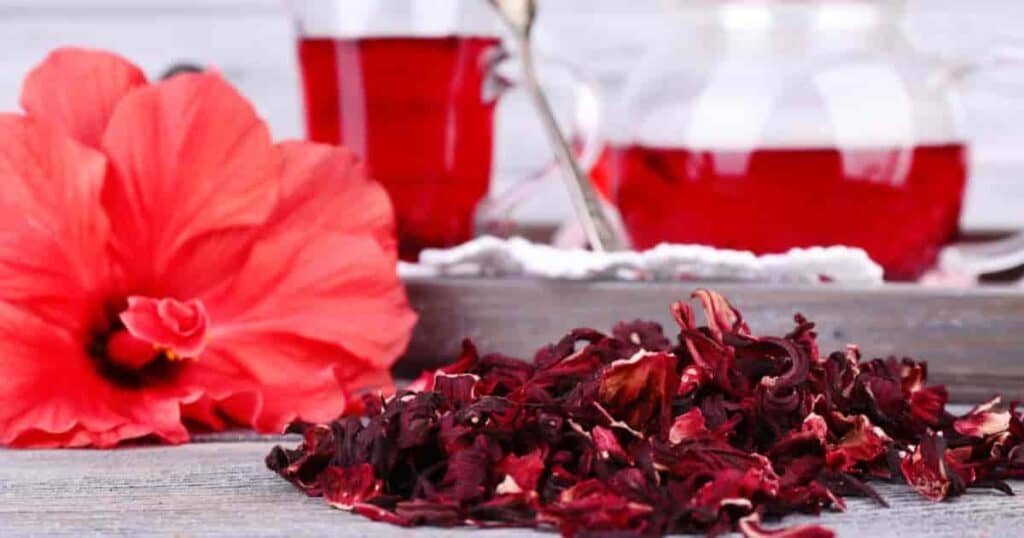A lot of people often ask, Are hibiscus flowers edible? Or can you eat hibiscus flowers? Well, the answer is a resounding YES!

Hibiscus flowers can be eaten from the plant or used to make jams, relishes, and teas. They are also known to have vitamins and nutritional value.
There are times, however, when you should be eating hibiscus flower. For example, if you are pregnant or allergic to the Malvaceae plant family, you should not eat or consume hibiscus flowers.
However, they generally help lower high blood pressure and can even have anti-cancer benefits.
Hibiscus Flower Health Benefits
Hibiscus flowers offer a unique flavor to different cuisines. Its taste pairs well with both savory and sweet ingredients.
The flowers of Hibiscus trees have a number of health benefits. For example, research suggests that hibiscus flowers aid those suffering from high blood pressure and cholesterol.
A research study also found that hibiscus flowers are effective with:
- Lowering blood sugar
- Lowering cholesterol levels
- Improving insulin resistance
- Heightening healthy cholesterol
More research still needs to be done for hibiscus flowers to be prescribed by doctors. However, the health benefits of research studies are enough for some people to try it and see results.
It has also been found that hibiscus flower aid has antioxidants that help cancer patients and people with liver damage due to the hibiscus extract that may improve liver steatosis.
The hibiscus flowers also reduce the risk of health complications like diabetes and heart disease, reduce hypertension, and lower blood pressure.

The antioxidants found in flowers can help protect the liver from stress and drugs associated with liver damage, like chemotherapy.
The antioxidants have also been found to kill breast cancer cells and release enzymes to prevent prostate cancer.
It’s also known to have vitamin C as an antioxidant, helping boost the immune system and preventing cell damage caused by free radicals in the body.
Moreover, drinking hibiscus tea may remove toxins and waste from the body, as it can act as a diuretic.
How To Eat Hibiscus Flower
There are a handful of ways to eat hibiscus flowers. You can do the following:
- Eat the flowers raw.
- Dry out the flowers and make them into hibiscus tea bags or syrup.
- Dry them out and make them into a jam or relish.
Moreover, hibiscus edible flowers can be used in jams, salads, or relishes.
Can you eat dried hibiscus flowers?
Yes, dried hibiscus flowers are edible and commonly used in many cultures to make tea, desserts, and other dishes.
The dried flowers have a tart, cranberry-like flavor and can be used to add color and flavor to recipes.
Some cultures value all parts of the hibiscus plant, including its jute-like fibers in the useful stems and its edible and spicy leaves, which can be eaten as a vegetable or used as a chutney-style condiment.
Additionally, recipes showcase the tasty ways to incorporate edible hibiscus flowers in different dishes.
It’s important to note that when consuming hibiscus flowers, the focus is often on the flower’s calyx, which refers to the collective grouping of a flower’s sepals.
The sepals are modified leaves that sit under a flower’s petals.
You might also wonder, can you eat hibiscus leaves?
The answer is also YES!
Aside from its flowers, you can also enjoy hibiscus leaves.
When Not To Eat Hibiscus Flowers
If you are pregnant or breastfeeding, avoiding eating hibiscus flowers is important. This is mostly because there is a lack of research and evidence on these flowers’ side effects on pregnant women.
Edible Hibiscus flowers may even interact negatively with the medication that you may be on. This may be antibiotics or birth control medicines.
If you are allergic to the Malvaceae plant family, avoiding consuming hibiscus flowers is crucial.
These edible flowers should only be consumed in moderation. If you consume too many hibiscus flowers, you may injure your liver.

What Hibiscus Flowers Are Edible?
There are many types of hibiscus species. Most are edible, but some are not. It is important to research any hibiscus species before you eat it.
The following hibiscus flowers are confirmed to be edible.
Hawaiian Hibiscus
The Hawaiian hibiscus is the bright, big yellow blooming hibiscus. There are seven types of these hibiscus plants, all edible.
Hibiscus Sabdariffa
The hibiscus sabdariffa or the Rosa de Jamaica has various colors. This species is known for being tart. It is also known as the Florida cranberry.
Hibiscus Acetosella
The Hibiscus acetosella (Cranberry Hibiscus) is edible but is mostly seen as a decorative plant. Their red flowers are usually overlooked as they are not normally seen.
Hibiscus Rosa – Sinensis
The Hibiscus rosa-sinensis is also known as the Chinese hibiscus. They can be used in salads or teas. The tea is notably fragrant.
The Chinese hibiscus is sometimes known as a shoeblack plant and has a dark-colored center in the flower and a bright-colored edge.
Hibiscus Sinosyriacus
The Hibiscus sinosyriacus is also known as the rose of Sharon. It is an Asian blooming hibiscus plant and a perennial that can grow well in most climates.
They are multi-colored, and flowers can bloom in blue, purple, white, red, or pink.
Which Hibiscus are not Edible?
Are all hibiscus edible?
While many species of hibiscus are edible and used in culinary preparations, some hibiscus varieties are not commonly consumed.
Certain species of hibiscus plants, including Hibiscus trionum, Acetosella hibiscus, and Hibiscus mutabilis, can be toxic if ingested.
The toxicity is present in the plant’s foliage, nectar, and flowers. These plants have evolved toxins to deter larger animals from eating them, and humans should also be cautious and keep pets away from them.
Symptoms of ingestion include vomiting, nausea, blurred vision, and skin irritation, and immediate medical attention should be sought if any of these symptoms occur.
